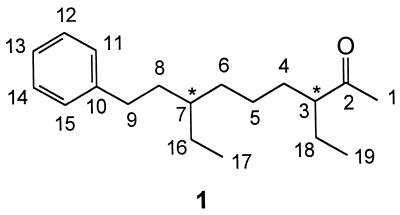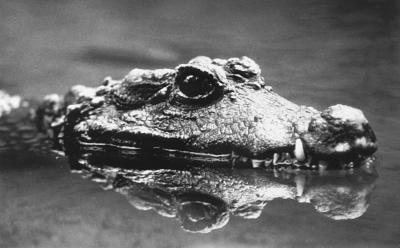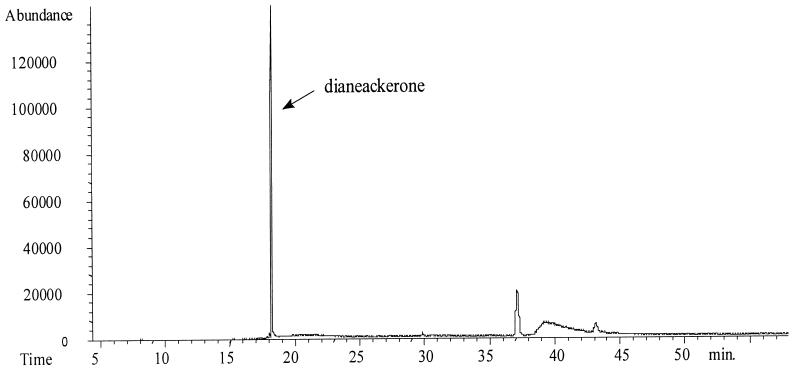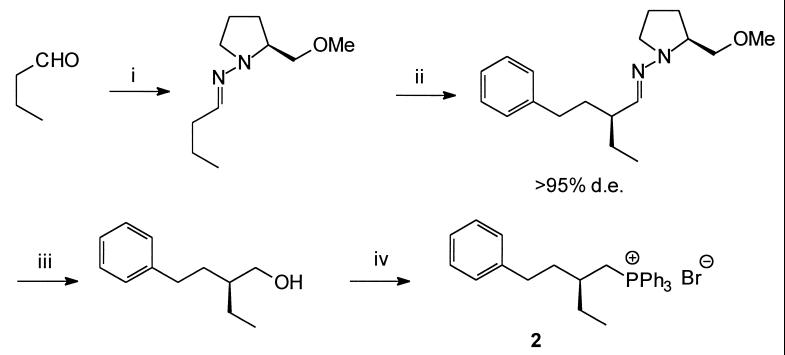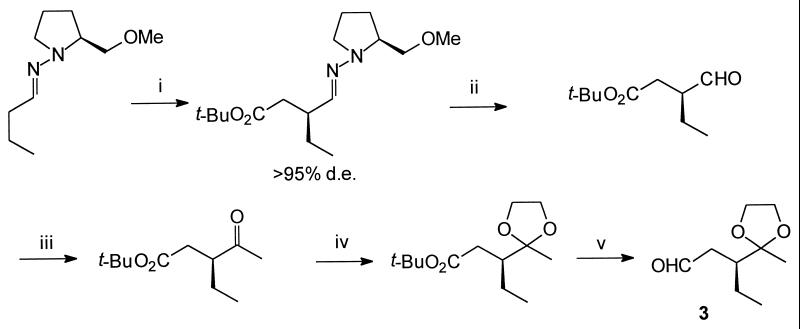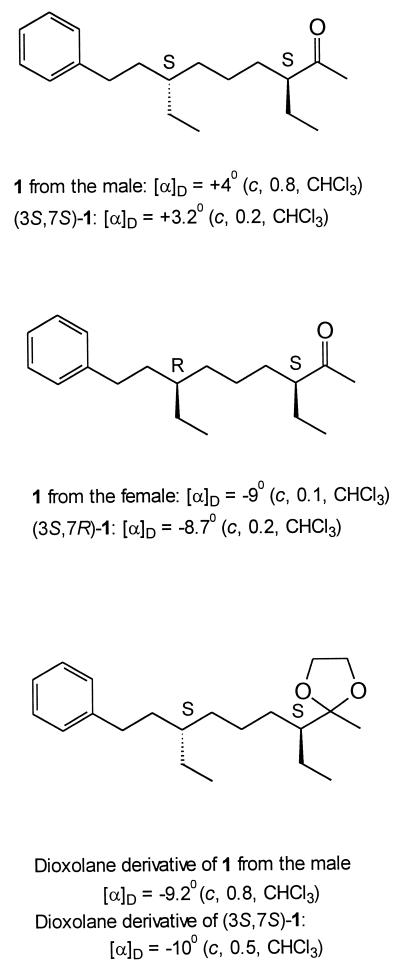Abstract
The major volatile component in the paracloacal glandular secretion of the adult African dwarf crocodile (Osteolaemus tetraspis) was isolated and characterized as a 19-carbon aromatic ketone, dianeackerone (3,7-diethyl-9-phenyl-2-nonanone). This ketone is absent from the secretion of immatures. Careful examination of dianeackerone samples isolated from individual adults revealed that this ketone occurs as both the (3S, 7S) and (3S, 7R) stereoisomers, with different individuals presenting strikingly different ratios of the isomeric forms. Our initial suspicion that the stereoisomeric dianeackerones might be indicators of gender proved untenable, leaving the role of these glandular constituents a challenge for future study.
Keywords: Osteolaemus tetraspis, paracloacal gland, pheromone, stereospecific synthesis
All modern crocodilians (Crocodylia, Reptilia) possess a pair of skin glands, the paracloacal glands, thought to secrete pheromones that play a role in nesting and/or mating activities (1). In previous chemical studies, a number of paracloacal glandular lipids have been characterized from members of the Alligatoridae (alligators and caimans; refs. 2–8). Some of these compounds are unusual natural products. Recently, for example, two macrocyclic diterpenes, cembrene A and a congeneric cembrenone, were identified from the secretion of the Chinese alligator, Alligator sinensis (8). Herein, we report the isolation, chemical characterization, and synthesis of the two naturally occurring stereoisomeric forms of dianeackerone (3,7-diethyl-9-phenyl-2-nonanone, 1; Fig. 1), the chief volatile component in the paracloacal glandular secretion of both sexes of the African dwarf crocodile, Osteolaemus tetraspis (Crocodylidae; Fig. 2).
Figure 1.
Dianeackerone (1) from O. tetraspis.
Figure 2.
O. tetraspis, photographed in the Pittsburgh Zoo (photo by Sarah Ewald, printed with permission).
Materials and Methods
Animals.
O. tetraspis, which inhabits swamps and slow-moving streams in the tropical forests of West and Central Africa, is heavily armored with pronounced, ossified dorsal and ventral scales. Adults, which rarely exceed 2 m in length, are uniformly black. Two subspecies are recognized, O. tetraspis tetraspis, which occurs throughout most of the species range, and O. tetraspis osborni, which is restricted to the Upper Congo and the Democratic Republic of Congo (9).
Secretion.
Samples of paracloacal gland secretion were collected from specimens at the Crocodile Conservation Services, Plant City, FL; Ellen Trout Zoo, Lufkin, TX; Fort Worth Zoo, Ft. Worth, TX; Jacksonville Zoo, Jacksonville, FL; Memphis Zoo, Memphis, TN; North Carolina Zoological Park, Ashboro, NC; Pittsburgh Zoo, Pittsburgh, PA; St. Augustine Alligator Farm, St. Augustine, FL; and one private collection (Lakeland, FL). Our initial studies involved analyses of samples from one adult male and one adult female. The final number of secretion donors included six adult males and five adult females, ranging from 8 to 35 years of age, and nine immatures (unsexed), 1 or 2 years of age. Secretion samples were obtained by restraining subjects while their paracloacal glands were manually palpated and compressed. The yellow oil discharged through the gland openings was collected in glass vials, covered with 4–6 ml of dichloromethane, and stored at −10°C. Each sample was diluted with 2 ml of chloroform-methanol (2:1, vol/vol), vortexed, and filtered through an Acrodisc CR PTFE 0.2-μm filter (Gilman Sciences, Ann Arbor, MI). Evaporation of this solution under a stream of nitrogen yielded ≈90 mg of residue from the males and about half that amount from the females.
Analytical Methods.
GC was carried out with a Hewlett–Packard 5890 Series II gas chromatograph by using a 30-m × 0.25-mm DB-5 (J & W Scientific, Fulsom, CA) fused silica column, chromatography-grade helium at a head pressure of 120 kPa as the carrier gas, and the following operating temperatures: injection port, 250°C; oven, 60°C for 4 min, programmed to 270°C at 15°C/min. GC-MS data were obtained at an ionizing voltage of 70 eV with a Hewlett–Packard 5970 mass selective detector. High-resolution MS data were recorded on a VG 70-S gas chromatograph/mass spectrometer. Ultraviolet spectra were obtained with a diode-array detector linked to a Hewlett–Packard 1090 HPLC instrument. A 25-cm × 4.6-mm ID INERTSIL ODS3 (5 μm) column (MetaChem Technologies, Torrance, Ca) was eluted with a solvent gradient of 80–100% CH3OH/H2O over 15 min at a rate of 1 ml/min. Dianeackerone eluted at 18.3 min and showed an ultraviolet absorption maximum at 206 nm. 1H- and 13C-NMR spectra were obtained on Varian Unity 500 and Varian VXR 400S NMR spectrometers, respectively. Heteronuclear multiple quantum correlation (HMQC) and heteronuclear multiple bond correlation (HMBC) experiments were performed on the Varian-500 instrument and were optimized for 1JCH = 140 Hz and 1JCH = 7 Hz, respectively. NMR spectra were recorded by using benzene-d6, and chemical shifts were referenced to the corresponding solvent signals.
Results
Analysis of the male’s secretion by GC-MS showed the presence of a single, major volatile component, dianeackerone (Fig. 3). Dianeackerone was isolated from the total extract by preparative HPLC. Its electron ionization mass spectrum showed a molecular ion at m/z 274, as well as significant fragment ions at m/z 105, 91, 86, and 43. High-resolution MS established its molecular formula as C19H30O (m/z observed = 274.2297; calculated for C19H30O = 274.2297). 1H- and 13C-NMR data (see Table 1), along with HMQC, HMBC, and correlated spectroscopy NMR experiments, led to the assignment of structure 1.
Figure 3.
Gas chromatogram of a 2:1 chloroform-methanol extract of male O. tetraspis secretion.
Table 1.
1H (500 MHz) and 13C (100 MHz) NMR Data for Dianeackerone (1) in benzene-d6
| Position | δ 1H, ppm | δ 13C, ppm | HMBC correlations, carbon no |
|---|---|---|---|
| 1 | 1.76 (s) | 28.84 | C-2, -3 |
| 2 | — | 210.34 | — |
| 3 | 2.14 (br m) | 54.94 | — |
| 4 | 1.50, 1.32 (m) | 33.83 | — |
| 5 | 1.19, 1.17 (m) | 25.12 | — |
| 6 | 1.16, 1.20 (m) | 32.15 | — |
| 7 | 1.22 (m) | 38.89 | — |
| 8 | 1.52, 1.46 (m) | 35.81 | C-7, -9, -16 |
| 9 | 2.55, (m) | 33.84 | C-7, -8, -10, -11, -15 |
| 10 | — | 143.62 | — |
| 11 | 7.15* (d) | 129.06 | C-9, -13 |
| 12 | 7.25†— (m) | 129.04 | C-10, -11 |
| 13 | 7.15* (m) | 126.36 | C-11, -15 |
| 14 | 7.25† (m) | 129.04 | C-10, -15 |
| 15 | 7.15 (m) | 129.06 | C-9, -13 |
| 16 | 1.30 (m) | 26.36 | C-6, -7 |
| 17 | 0.83 (t) | 11.27 | C-7, -16 |
| 18 | 1.45 (m) | 25.16 | C-2, -3, -4, -19 |
| 19 | 0.75 (t) | 12.23 | C-3, -18 |
s, singlet; br, broad; m, multiplet; d, doublet; t, triplet.
*
Identical superscripts represent overlapping 1H signals.
Analysis of the paracloacal gland secretion from a female again led to the isolation and identification of dianeackerone (1) as the chief volatile constituent. The GC-MS and 1H-NMR (500 MHz) data obtained for this sample were indistinguishable from those obtained for the sample of 1 from the first male examined. However, a slight difference was observed in the 13C-NMR spectra of the two samples; the male sample showed its C-8 and C-16 resonances at δ 35.81 and 26.36 ppm, respectively, whereas the female sample showed the corresponding resonances at δ 35.89 and 26.27 ppm. To ascertain whether these small differences might be due to experimental error, the 13C-NMR spectrum of a solution containing comparable amounts of dianeackerone from the male and the female was recorded; the resulting spectrum showed doublets for the C-8 and C-16 resonances, whereas the remaining resonances were superimposed. These observations suggested that the male and female yielded different diastereomers of 1. To explore this possibility, we determined the stereochemistry of the natural materials by carrying out stereochemically unambiguous syntheses of two individual diastereomers of structure 1.
By means of the well established methodology of Enders (10, 11), chiral precursors 2 and 3 were prepared by using (S)-(−)-1-amino-2-(methoxymethyl)pyrrolidine (SAMP) as the chiral auxiliary, as outlined in Figs. 4 and 5. These precursors were then coupled by a Wittig reaction to give (3S, 7R)-1 after reduction and deprotection (Fig. 6). In entirely analogous fashion, (3S, 7S)-1 was prepared by using the enantiomeric chiral auxiliary [(R)-(+)-1-amino-2-(methoxymethyl)pyrrolidine rather than SAMP] in the first step of the synthesis (Fig. 4). Although the 500-MHz 1H-NMR spectra of the two diastereomers produced by these syntheses were indistinguishable, the C-8 and C-16 13C-NMR resonances of the synthetic diastereomers showed differences of less than 0.1 ppm, agreeing with the observations made previously for the samples of dianeackerone isolated from the male and female secretions. In fact, the 13C-NMR spectrum of a sample of 1 from the male coincided exactly with that of the synthetic (3S, 7S)-1, whereas 1 from the female coincided with that of synthetic (3S, 7R)-1.
Figure 4.
Reagents and conditions: i, (S)-(−)-1-amino-2-(methyoxymethyl)pyrrolidine, 0°C–room temperature (rt), 4 h, 87%; ii, a) lithium diisopropylamide, 0°C, 5 h; b) PhCH2CH2I, −110°C, 65%; iii, a) MeI, 60°C, 4 h; b) 4 M HCl, pentane, 1 h; c) BH3-tetrahydrofuran, 0°C–rt, 1 h, 80%; iv, a) N-bromosuccinimide, PPh3, dimethylformamide, 60°C, 12 h; b) PPh3, 120°C, 24 h, 55%.
Figure 5.
Reagents and conditions: i, a) lithium diisopropylamide, ether, 0°C–rt, 4 h; b) BrCH2CO2But, −110°C, 60%; ii, O3, CH2Cl2, −78°C, 82%; iii, a) MeMgI, ether, −78°C, 30 min; b) CrO3, H+, 0°C, 2 min, 68%; iv, (CH2OH)2, CH(OMe)3, TsOH, rt, 4 h, 92%; v, a) lithium aluminum hydride, ether; b) pyridinium dichromate, CH2Cl2, rt, 24 h, 62%.
Figure 6.
Reagents and conditions: i, a) n-BuLi, tetrahydrofuran, 0°C, 2 h; b) 3 rt, 12 h, 82%; ii, H2, Pd-C, MeOH, 95%; iii, pyridinium p-toluenesulfonate, acetone, H2O (9:1), 60°C, 1 h, 90%.
These results do not yet establish whether the male-derived compound is actually (3S, 7S)-1 or its (3R, 7R) enantiomer, because enantiomers have identical NMR spectra. This distinction was readily made, however, by comparing the specific optical rotations of the synthetic and natural materials. From the observed optical rotations, the absolute configurations of the male- and female-derived 1 were shown to be identical to those of the synthetic samples (Fig. 7). (In the case of the male sample, whose specific rotation is only +4o, the larger, negative rotations of the readily prepared dioxolane derivatives included in Fig. 6 confirmed these conclusions.)
Figure 7.
Observed optical rotations of natural and synthetic dianeackerone samples.
To check whether this stereochemical difference is indicative of a consistent sexual dimorphism and to look into the possible production of dianeackerone by immatures, we obtained secretion samples from an additional 18 individuals, including 9 adult and 9 immature specimens. The chemical analytical results were baffling. Although the immatures yielded paracloacal secretion (albeit in lesser amount) and small amounts of cholesterol along with free C14, C16, and C18 fatty acids were detected, none of the samples contained either stereoisomer of 1. The adults, however, consistently yielded 1 but with no clear stereoisomeric distributional pattern (Table 2). Although two of the five additional males available to us matched the first male in that they produced (3S, 7S)-1 to the virtual exclusion of (3S, 7R)-1, two of the remaining males showed just the reverse [predominantly (3S, 7R)-1 with the virtual exclusion of (3S, 7S)-1], and one male yielded both diastereomers in comparable amounts. Similarly, although one additional female produced (3S, 7R)-1 to the virtual exclusion of (3S, 7S)-1, the remaining three females produced comparable amounts of both diastereomers.
Table 2.
Dianeackerone Diastereomeric Ratios Found in O. tetraspis Adults
| Crocodile | Sex | Location | Ratio of (3S, 7S)-1:(3S, 7R)-1 |
|---|---|---|---|
| 1 | Male | Ashboron, NC | >9:1 |
| 2 | Male | Ashboron, NC | >9:1 |
| 3 | Male | Plant City, FL | >9:1 |
| 4 | Male | Memphis, TN | ∼2:1 |
| 5 | Male | Lakeland, FL | <1:9 |
| 6 | Male | Pittsburgh, PA | <1:9 |
| 7 | Female | St. Augustine, FL | <1:9 |
| 8 | Female | St. Augustine, FL | <1:9 |
| 9 | Female | Memphis, TN | ∼1:1 |
| 10 | Female | Lufkin, TX | ∼1:2 |
| 11 | Female | Ft. Worth, TX | ∼1:1 |
No dianeackerone was detected in the secretion of nine immatures.
We have no explanation of these results, although it is clear that the varying ratios of dianeackerone stereoisomers in both sexes exclude the possibility of these compounds serving as unequivocal indicators of gender. This striking variation may be attributable to a number of factors. The proportions may vary between the subspecies, a possibility we are unable to evaluate, because the geographical origins of our subjects are unknown. Maturational factors may also be involved, a distinct possibility considering that our adult subjects ranged in age from 8 to 35 years. Whether, alternatively, these isomers function as signaling agents to convey information about other adult parameters, such as genetic quality or physiological status, cannot be established on the basis of the existing evidence. For the present, therefore, the biological significance of these compounds remains an open question.
Acknowledgments
We have named compound 1 to honor Diane Ackerman, author and poet, whose exquisite writings in the field of natural history have increased our awareness of the value of biodiversity and of the urgent need to protect endangered species. B. Schwedick (Crocodile Conservation Services), C. Falzone, D. Ferri, B. Henley, G. Henley (Ellen Trout Zoo), D. Blody, L. Greenup, B. Jacobs, T. Wagener (Forth Worth Zoo), J. Carter, G. Lepera, J. Tomlinson (Jacksonville Zoo), D. Harris, R. Millican, S. Reichling (Memphis Zoo), J. D. Groves, T. Norton, B. Parker, C. Tinsley (North Carolina Zoological Park), W. Langbauer, R. Bamrick, M. Lebanik (Pittsburgh Zoo), V. Dixon, L. Kirkland, J. Keller, D. Kledzik, E. Martin, W. Puckett (St. Augustine Alligator Farm), and T. Scott (Lakeland, FL) permitted access to animals in their care. J. W. Avery and J. L. Kachinski, Jr., performed high-resolution MS. The partial support of this research by National Institutes of Health Grants GM 53830 and AI 02908, including a Postdoctoral Supplement to A.W., as well as a Research Corporation Grant, is acknowledged with pleasure.
Abbreviations
- HMQC
heteronuclear multiple quantum correlation
- HMBC
heteronuclear multiple bond correlation
- rt
room temperature
References
- 1.Weldon P J, Ferguson M W J. Brain Behav Evol. 1993;41:239–245. doi: 10.1159/000113845. [DOI] [PubMed] [Google Scholar]
- 2.Fester G, Bertuzzi F. Chem Ber. 1934;67:365–370. [Google Scholar]
- 3.Fester G, Bertuzzi F A, Pucci D. Chem Ber. 1937;70:37–41. [Google Scholar]
- 4.Weldon P J, Shafagati A, Wheeler J W. Lipids. 1988;23:727–729. doi: 10.1007/BF02535676. [DOI] [PubMed] [Google Scholar]
- 5.Shafagati A, Weldon P J, Wheeler J W. Biochem Syst Ecol. 1989;17:431–435. [Google Scholar]
- 6.Dunn B S, Jr, Weldon P J, Howard R W, McDaniel C A. Lipids. 1993;28:75–78. doi: 10.1007/BF02536366. [DOI] [PubMed] [Google Scholar]
- 7.Avery J, Shafagati A, Turner A, Wheeler J W, Weldon P J. Biochem Syst Ecol. 1993;21:533–534. [Google Scholar]
- 8.Mattern D L, Scott W D, McDaniel C A, Weldon P J, Graves D E. J Nat Prod. 1997;60:828–831. doi: 10.1021/np970129v. [DOI] [PubMed] [Google Scholar]
- 9.Wermuth H, Mertens R. Schildkröten, Krokodile, Brückenechsen. Jena, Germany: Fischer; 1961. [Google Scholar]
- 10.Enders D, Eichenauer H. Chem Ber. 1979;112:2933–2960. [Google Scholar]
- 11.Enders D, Eichenauer H. Tetrahedron Lett. 1977. 191–194. [Google Scholar]



